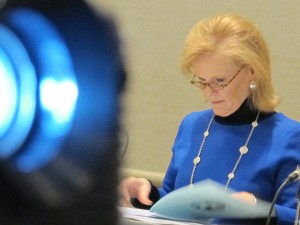The Long, Long Road Ahead Of Indiana's College Completion Advocates

Kyle Stokes / StateImpact Indiana
Indiana Commissioner for Higher Education Teresa Lubbers prepares for a December 2011 meeting.
In a speech broadcast statewide this week, Indiana’s top higher education official reiterated her commitment to a goal we’ve written about before — to exponentially increase the rate at which Hoosiers earn college degrees.
“We have set a big goal of increasing the number of Hoosiers with education beyond high school to 60 percent of the state’s adult population by the year 2025,” Commissioner for Higher Education Teresa Lubbers said Wednesday.
“But,” Lubbers continued, “Indiana’s big goal faces a big gap.”
How big? Roughly one-third of Hoosiers currently hold a two- or four-year college degree, as Lubbers points out and data from the Indianapolis-based Lumina Foundation corroborates.
And as if to illustrate the enormity of the challenge ahead for those who aim to boost the state and country’s college completion rates, the U.S. Department of Education released projections this week showing growth in the number of degrees — but by figures well below what’s needed to meet a goal of 60 percent completion.
As the Lumina Foundation sums up the “60 percent” goal:The percentage of Americans between the ages of 25 and 64 with a two- or four-year degree is 38.3 percent. Yet we know that 65 percent of U.S. jobs will require some form of postsecondary education by 2020. To reach Goal 2025, the nation must produce 62 million high-quality degrees and credentials over the next 12 years. At current rates, the U.S. will produce around 39 million two- and four-year college degrees by 2025, leaving a gap of 23 million [new credentials].
But the National Center for Education Statistics’ estimates show that in 2021, the U.S. will produce far short of 23 million new college degrees.
Between associates, bachelor’s, master’s degrees and doctorates, U.S. colleges will graduate roughly 681,000 more credential-holders in 2022 than they did in 2009.
The NCES also projects the total number of bachelor’s degrees to increase by 21 percent between 2009 and 2022.
In this light, Lubbers acknowledged the enormity of the task of increasing Indiana’s college completion rate in her speech:
Moving that number will be tough for Indiana, especially when you consider that only two states in the nation have a greater percentage of adults with a high school diploma as their highest level of education.
But consider the alternative: Nearly two-thirds of the jobs in Indiana this decade will require more than a high school diploma. And what if states around us meet the 60 percent goal and swallow up the jobs and economic opportunities that Hoosiers need and deserve? We become a state of lesser opportunity as more of the available jobs favor higher skilled and more highly-educated workers. This is not an inevitable course if we invest in the development of Indiana’s human capital.
